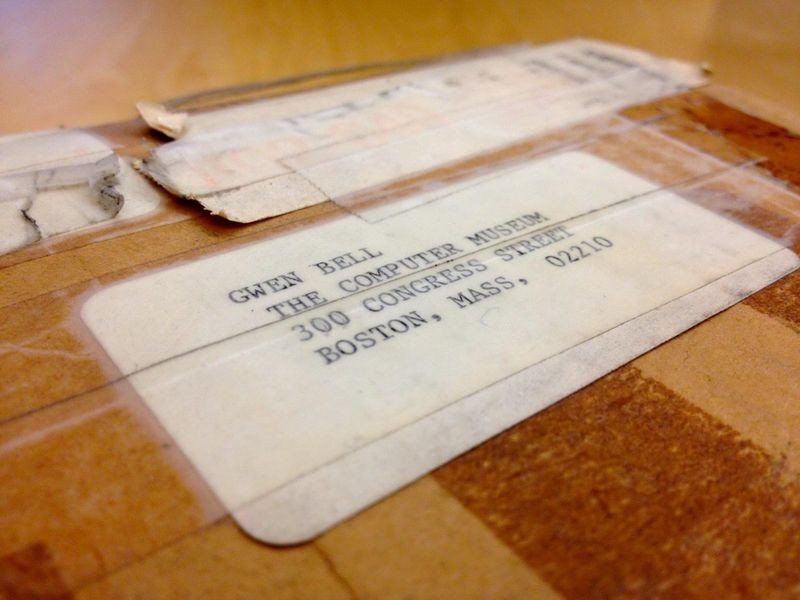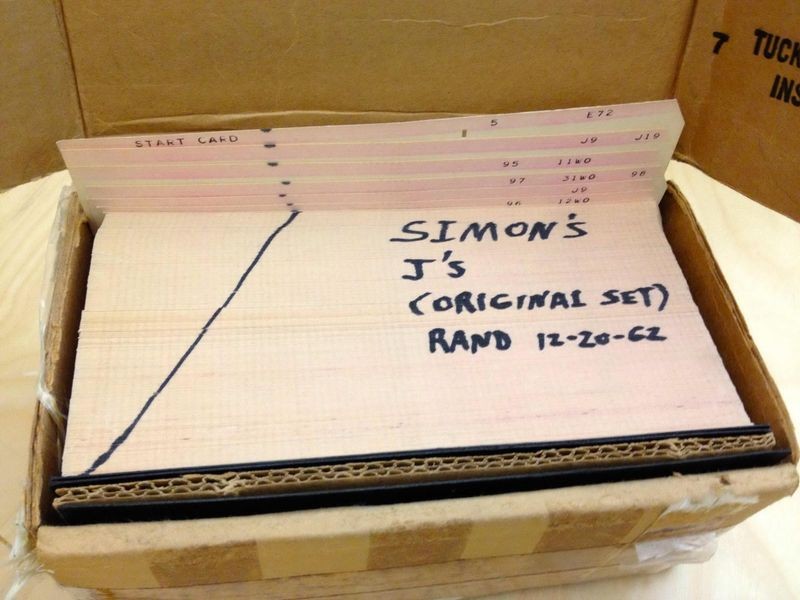

The 450 punched cards were shipped in a simple cardboard box to Gwen Bell, the president and co-founder of The Computer Museum.
About five years ago, I noticed a box of punched cards that Senior Curator Dag Spicer had set aside. It had been sent by high-performance computing researcher Lloyd Fosdick to the Museum’s forerunner, The Computer Museum, in 1985 and somehow made the trip from Boston to California when the collection was transferred. Alas, neither Dag nor I could make sense of the inscription written upon the edge of the card deck: “SIMON’S J’S (ORIGINAL SET) RAND 12-20-62”. Dag had contacted Fosdick in 2001, but unfortunately he couldn’t recall what the deck contained or how he came to donate it so many years prior. This presented an intriguing mystery.
We speculated that “SIMON” was likely in reference to Turing Award- and Nobel Prize-winning scientist Herbert Simon who had conducted fundamental research into artificial intelligence with Clifford Shaw at the RAND Corporation. What “J’s” are was completely unclear however. At that point, with work on the Museum’s new Revolution exhibition keeping us all very busy, I decided to engage one of the Museum’s dedicated volunteers, Mary Ellen Petrich.
Mary Ellen took on the job of transcribing some of the cards and trying to identify their contents. Was it code? Was it data? For what computer were these cards intended? She started to look into the physical format of the cards and found that based on the square corners, these cards were certainly from before 1965. The content of the cards was also unmistakably not binary and Mary Ellen started to consider the possibility that these cards were source code. No language known to her matched the format though and it also was not assembly language for any of the machines that the RAND Corporation used at the time.

The only identifying text on the cards was “Simon’s J’s (original set) RAND 12-20-62″.
Herb Simon, Cliff Shaw, and Allen Newell created several artificial intelligence programs at RAND and an early list processing language called IPL (Information Processing Language). IPL went through an evolution of different versions and influenced the better-known Lisp language. When Mary Ellen came to me with the suggestion that maybe these cards were in IPL, I was as emphatic as I was wrong in my assertion that it wouldn’t be; it didn’t quite look the way that I remembered IPL. But as we went through the literature, not only did we find the confirmation that this was in fact IPL, but a library of standard subroutines called “J’s”. These basic processes implemented tasks like constructing lists or managing memory. Data and code routines in IPL are named with a single character followed by a number. The letters ‘H’ and ‘W’ are reserved for data storage and ‘J’ for the collection of routines implementing the basic processes.
Robert N. Miner Software Curator Al Kossow had read in the whole set of cards and also scanned some relevant documents. We felt that these particular “J’s” were part of IPL-V and Mary Ellen continued her research. She located Chuck Baker who at RAND had implemented IPL-V for the IBM 704/709/7090 computers. He confirmed that we did have a deck of “J’s” for IPL-V and explained that not all of the subroutines could be implemented in IPL itself – J2 for example performed an equality test and was implemented as a system primitive. This explained the gaps in the sequence of “J’s”.

Punched cards could have their contents printed on the top edge for easier identification. In 1962, IBM still used square corners for their standard punched card stock.
Using a standard library to implement frequently used (or even fundamental) functions is a common technique; current programming languages’ definitions are dwarfed by the size of their libraries. Powerful libraries increase the abstraction level and allow the programmer to focus on the logic of the program without getting distracted by the minutiae of implementation.
Every artifact comes with a story. Often, these stories are little known or change over time as can be witnessed on popular television shows like Antiques Roadshow. Museums attempt to preserve these stories along with the artifacts to provide source material for research and historical interpretation. The “Simon’s J’s” are an example of a successful collaboration between the Museum’s staff, volunteers, and donors to reattach a previously lost story to an artifact in the collection. Not only does that make the artifact more useful to researchers, but it also was an enjoyable and educational discovery for everybody involved.